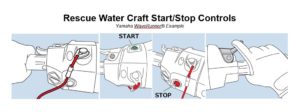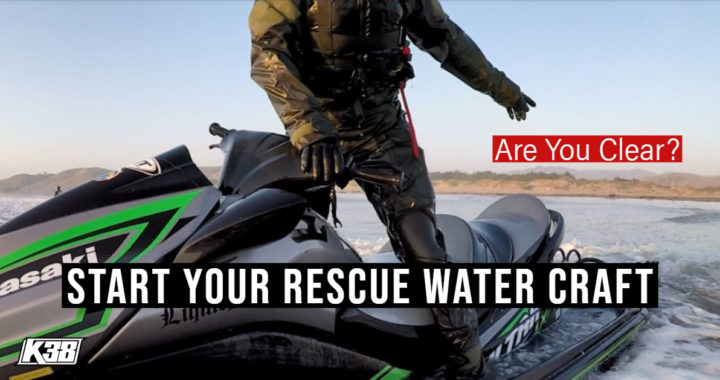LANYARD
Let’s go over a start procedure basic for your Rescue Water Craft (RWC). We’ll being with learning how to use the Engine Cut-Off Switch
Keep Engine Cut-Off Switch/Lanyard Attached
Securely attach engine shut-off cord (lanyard) to your lower left webbing strap on your Lifejacket (PFD) and wear it at all times.
Then, if you experience a ‘Coxswain man overboard’ mishap from the RWC, the engine will stop. However, be mindful and engine cut off switch/cord can break.
The only time this would not apply is if you were using the Emergency Cut-Off Switch that is secured to the helm.
If you had this engaged during an emergency where your personal lanyard broke and fell overboard the Rescue Water Craft would continue to operate on the path the helm position rests or is influenced by.
This could cause a secondary emergency underway and a possible mishap. Be mindful of the decision to engage for the purposes of emergency.
KNOW HOW TO START/STOP THE ENGINE

RWC start stop features*
You have your engine cut-off switch engaged in the start position.
Some models of Rescue Water Craft may have you engage an immobilizer key first such as a Kawasaki Jet Ski™ Ultra model, by pushing this key inward to turn on the electrical system.
Look astern. Ensure that your stern area is clear visually. As the Coxswain you will rotate your body in a standing position facing the helm by looking over your left shoulder and slightly rotating your pelvis in the same direction.
If not clear, wait to start the craft until 'all clear'.
CLEAR!
Be ready to pivot your body slightly to look towards the portside quarter astern. Your right hand will remain fixed on the starboard side handle or start the craft by pushing in the start button or green button on the portside helm.
When you conduct the stern check, point downwards towards the area on the water where the water jet thrust exists from the steering nozzle and insure you are ‘all clear’ prior to starting the Craft. State the word ‘CLEAR’ loudly if persons are in the vicinity of your 30’ Rule.
To start the engine, be sure that the lanyard is attached and push the start button. Simultaneously make sure your forward progress is all clear.
1. To stop the engine, push the stop button.
Stopping the engine will not stop the forward motion of the RWC and will result in loss of steering.
K38 asks that you inspect the engine cut-off switch after each operation. You will be looking for damage to the coil, wrist loop, clip and plastic key piece. Remove from service if damaged.
When you start the craft on a trailer or a beach cart, do not allow the engine to run more than 10 seconds without water running through the exhaust cooling system. The manufacturers will recommend up to 15 seconds. Do not dry-rev the engine over 4,000rmp. Note some manufacturers will recommend 6,000rmp.
To stop the engine, push the 'red or stop' button, you may also pull the engine cut-off switch from its connected position to the helm. Secure it for safety.
Please refer to the Manufacturer’s Owner’s Manual for the specific Make Model and Year of Production. You will find the details of everything RWC needed!
Note: this article does not represent the functions of Neutral, Reverse, Trim, Braking or Forward, this is only a reminder of how to start the craft.
*Reference: https://global.yamaha-motor.com/business/waverunner/fanandproper/pwc_controls.html
______________________
Posted: June 15, 2019
Content Creator of Rescue Water Craft and Personal Water Craft boating international education standards: Shawn Alladio is the world’s foremost authority and leading subject matter expert. She cares most about her community and the culture surrounding the safety of event service providers and Rescue Water Craft operators, working hard and dedicated towards protecting their reputation, distributing safety information and continuing to train these amazing individuals to the highest standards of care.
__________
Have any questions? Join the Rescue Water Craft Association
and discover what your community is doing to modernize standards, safety and reduce liability!
Join the Rescue Water Craft Association
Use at your own risk. Please take a qualified Rescue Water Craft training course and maintain proper records and respect all the PWC, RWC, PPE, and gear OEM manufacturer warning labels and cautions.
